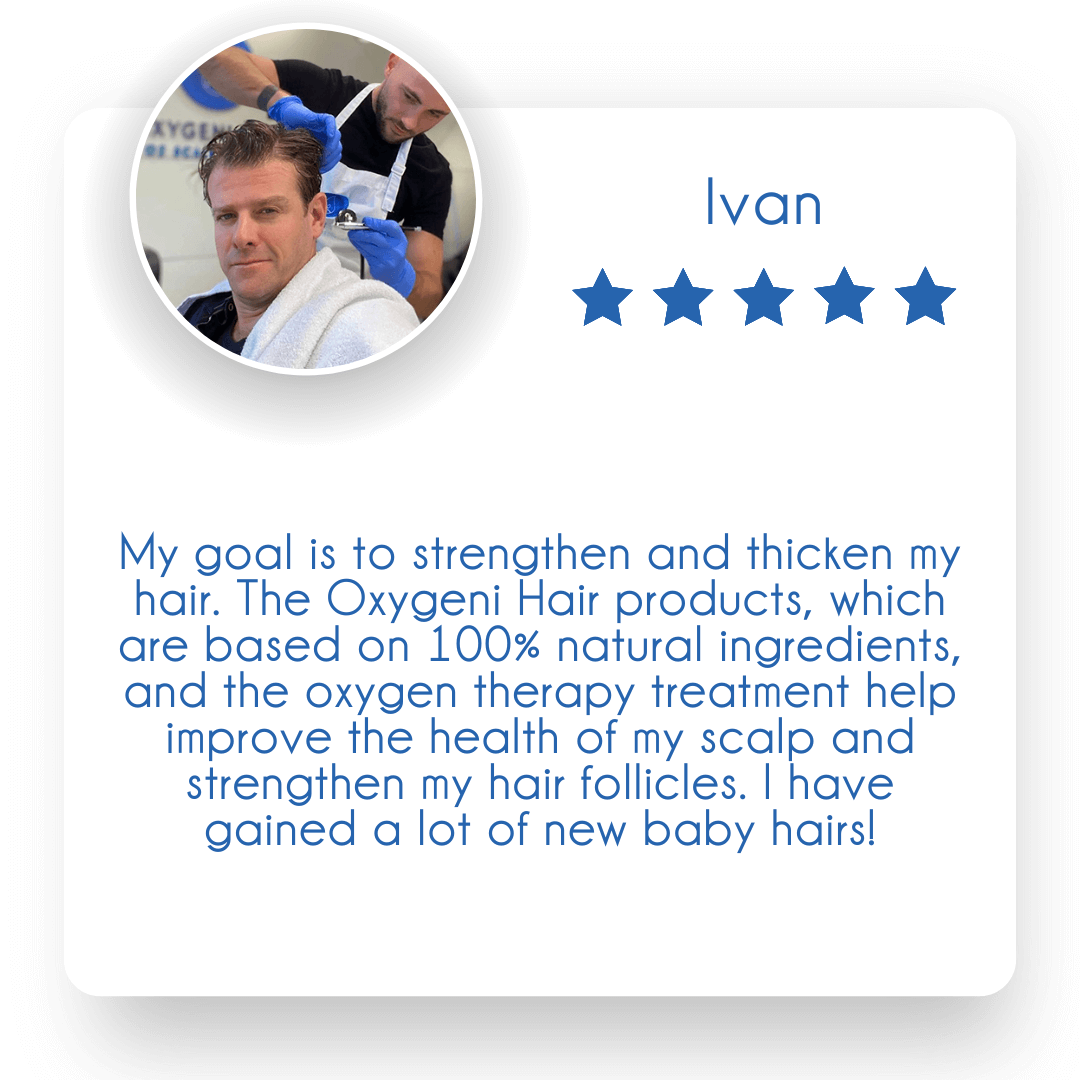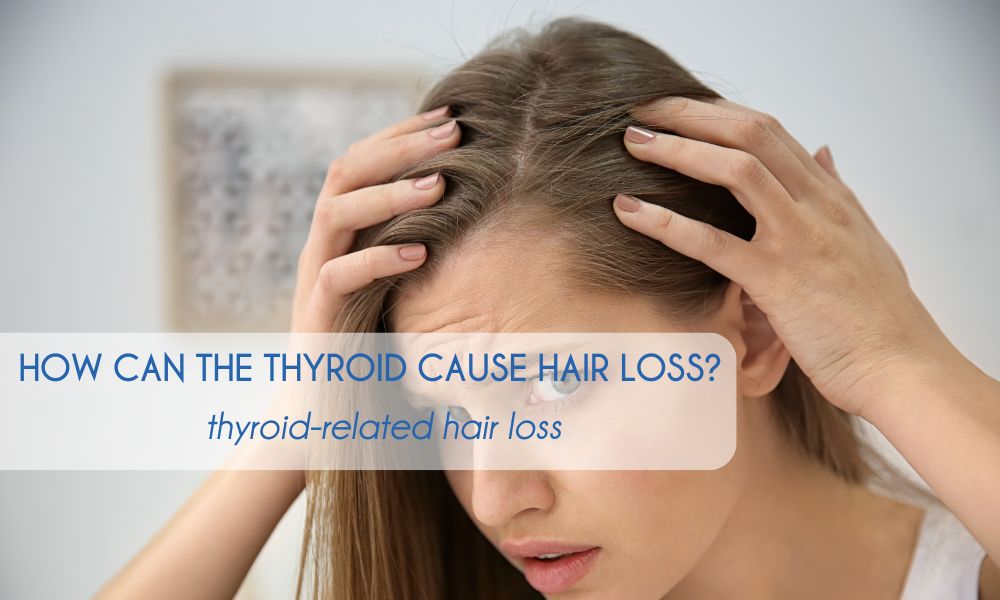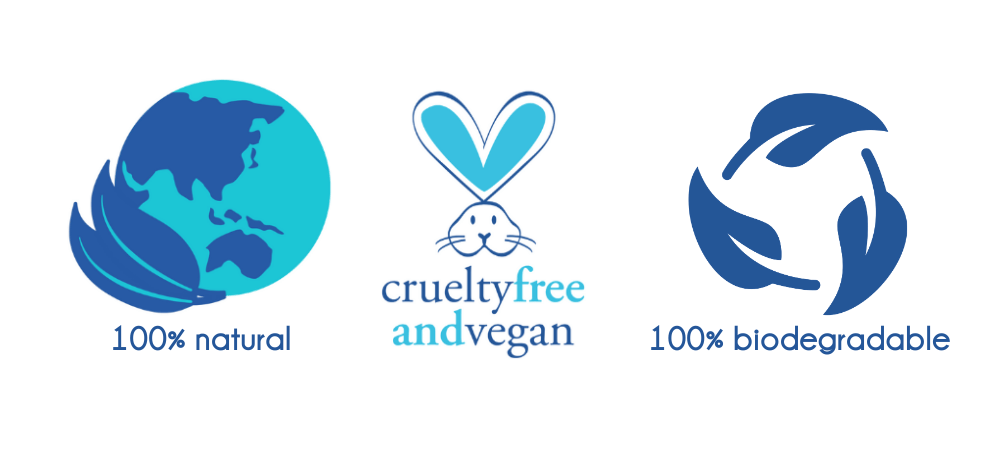Scalp Pain
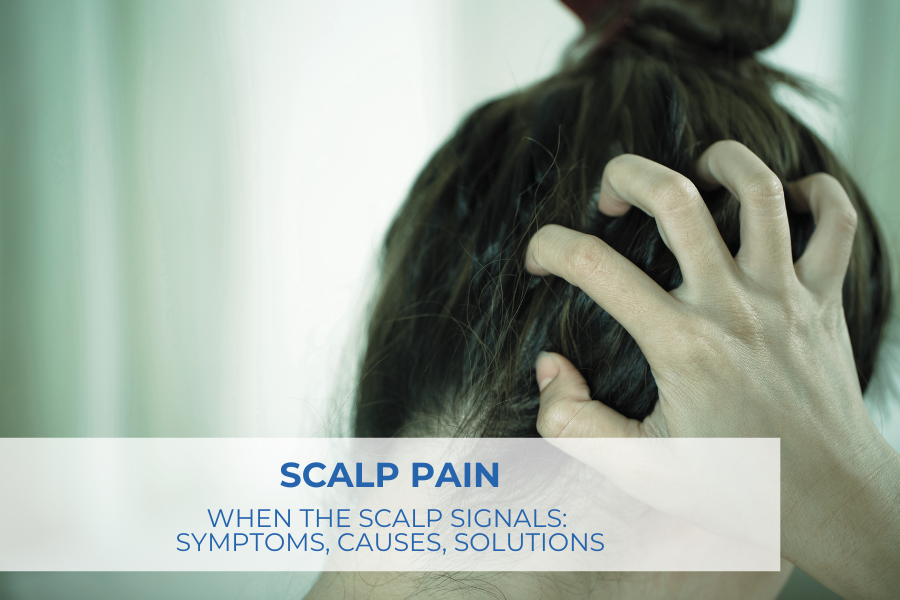
SCALP PAIN – SYMPTOMS, CAUSES, SOLUTIONS
Scalp pain is an uncomfortable sensation that affects many people, yet few talk about it. This sensitivity can manifest in various forms, such as tightness, tingling, burning, or stabbing pain. While it is often temporary and mild, it can sometimes indicate more serious underlying issues. This blog aims to explore the possible causes of scalp pain, treatment options, and offer useful tips for prevention. Whether it stems from improper hair care habits, stress, or health conditions, recognizing and addressing the symptoms in time is essential for maintaining a healthy scalp.
WHAT EXACTLY IS SCALP PAIN?
Scalp pain is a complex and diverse issue that often goes unnoticed, as people tend to dismiss the symptoms as minor discomfort. This pain can appear in various forms, ranging from mild, occasional irritation to persistent, severe discomfort.
Although it may seem harmless at times, scalp pain can sometimes indicate more serious underlying health issues. Recognizing and understanding the symptoms is essential for effectively addressing the problem.
Characteristics of Scalp Pain
Scalp pain manifests in various forms, often linked to different underlying causes. One of the most common complaints is a burning sensation, which may indicate that the scalp is irritated. This frequently occurs when the skin reacts sensitively to chemicals, such as hair dyes or strong cleansing agents.
Another common symptom is itching, usually caused by a dry scalp or an allergic reaction. Itching is often accompanied by increased flaking or dandruff, which can further aggravate the condition of the scalp. Tenderness to pressure is also a frequent issue, occurring when the scalp becomes painful to the touch. This can be particularly bothersome during hair washing or brushing, as the pain tends to intensify with these activities.
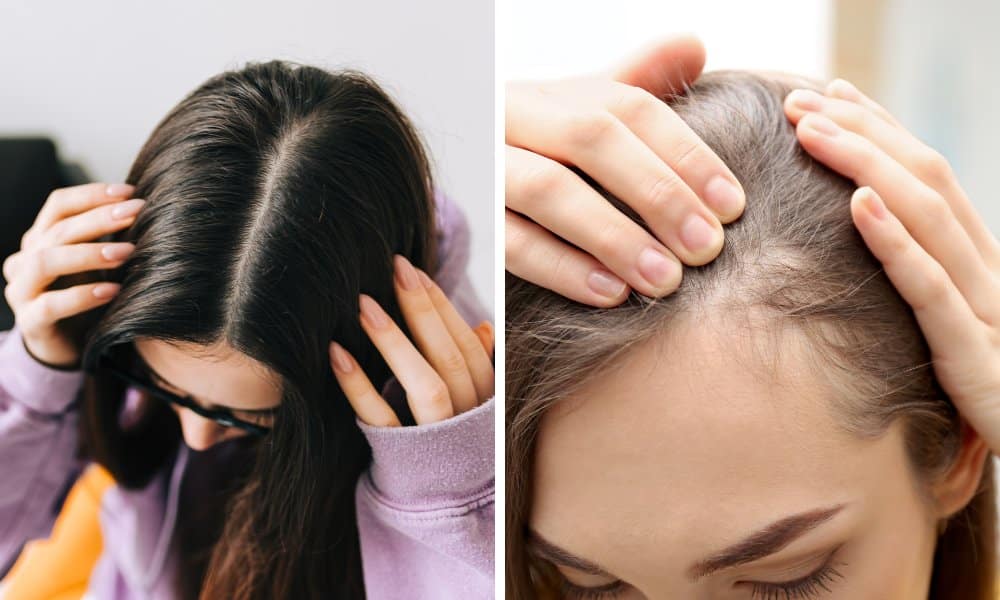
Tingling and stinging sensations are also common symptoms, often originating from nerve-related issues. These sensations can appear suddenly and may persist for varying durations and intensities. Due to the diverse nature of symptoms, scalp pain can differ from person to person, with underlying causes varying significantly as well.
Pain Localization
The localization of scalp pain can reveal a lot about the nature of the problem. The pain may affect the entire scalp, but it’s also common for it to target specific areas. For example, pain around the hairline is often linked to hairstyling habits, such as wearing tight ponytails or headbands.
Pain at the crown of the head or at the nape is frequently associated with muscle tension in the neck and shoulders, which can be caused by stress or poor posture. On the other hand, pain that affects the entire scalp often indicates an internal issue, such as a circulatory disorder or an inflammatory condition. In such cases, an accurate diagnosis is especially important, as the pain’s cause is often the result of multiple factors working together.
Temporary or Chronic Pain
Scalp pain can be classified into two main types based on its duration: temporary and chronic. Temporary pain typically lasts for a short period and is often linked to an external factor, such as an irritating hair care product or a tight hairstyle. This type of pain can usually be relieved by eliminating the cause, such as adjusting hair care habits.
In contrast, chronic pain persists for a longer time and often indicates an underlying internal issue. It may be caused by inflammation, nerve problems, or even hormonal imbalances. This type of pain does not always improve with simple lifestyle changes, so professional evaluation may be necessary for an accurate diagnosis and appropriate treatment.
Understanding the causes behind scalp pain is essential for effective treatment and preventing the symptoms from returning. Below, we explore the most common triggering factors that can contribute to the development of scalp pain.
THE MOST COMMON CAUSES OF SCALP PAIN
Scalp pain is often a result of daily habits, external factors, or even more serious health conditions. To effectively treat or prevent it, it is important to understand the circumstances that contribute to its development. Below, we provide a detailed overview of the most common causes to help you identify what might be behind your symptoms.
Hair Pulling and Tight Hairstyles
One of the most common causes of scalp pain is wearing overly tight hairstyles. Tight ponytails, buns, or braids put constant tension on the hair and scalp, which can lead to pain and sensitivity over time. This mechanical strain affects not only the scalp but also the hair follicles, potentially leading to hair loss. This type of pain usually subsides once the hairstyle is loosened, but if it occurs regularly, it may be worth reconsidering your hair styling habits.
Scalp wound
The scalp is a particularly sensitive area, so even minor wounds can cause pain. Sunburn, which is most common during the summer months, is one of the most frequent forms of injury. Intense UV exposure to the scalp can not only cause a burning sensation but also lead to inflammation. Additionally, mechanical injuries, such as abrasions or overly vigorous brushing, can also trigger discomfort and sensitivity. During the healing process of minor scalp injuries, the skin is often even more sensitive, so gentle hair care is essential.
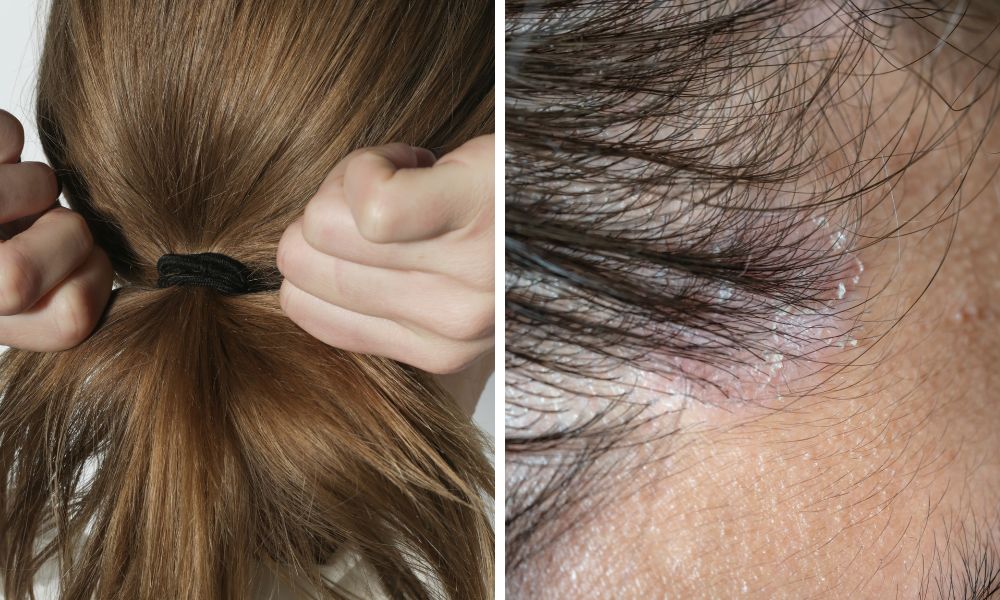
Irritation from Hair Care Products
Many people don’t consider that hair care products can also trigger scalp pain. Certain ingredients in hair dyes, shampoos, and conditioners, such as sulfates, parabens, or fragrances, can irritate the scalp. This is especially common for those with sensitive skin and may result in itching, a burning sensation, or even inflammation. When trying a new hair care product, it’s important to watch for these symptoms.
Health-Related Causes
Health problems are also common underlying causes of scalp pain. Seborrheic dermatitis, for example, is an inflammatory skin condition that causes oily, itchy, and inflamed areas on the scalp. The affected areas can become painful to the touch, especially if the inflammation worsens. Another common condition is psoriasis, which creates thick, scaly patches on the scalp. These inflamed areas can be not only itchy but also painful, especially when brushing.
Infections also play a significant role. Bacterial infections can lead to painful lumps or inflammation, while fungal infections, such as tinea capitis, can cause hair loss and painful symptoms. These issues often require medical treatment.
Stress and Psychological Factors
Stress not only affects overall well-being but also impacts the condition of the scalp. Chronic stress often leads to muscle tension in the shoulders, neck, and scalp area. This tension can affect the scalp’s blood vessels, causing pressure sensitivity and pain. Many people report that scalp pain during stressful periods becomes particularly uncomfortable, as the scalp muscles remain tense.
Managing such pain is often achieved through stress-relieving techniques, such as meditation or massage. The various causes can also amplify each other, so it’s important to observe what triggers the symptoms.
How to Identify the Cause of Scalp Pain?
Scalp pain can present in many ways, so identifying the exact cause is crucial for effective treatment. One of the most important steps is analyzing the symptoms. A burning sensation often points to some kind of irritation, typically triggered by hair care products like hair dyes or chemicals. This pain is often accompanied by redness or swelling, which may indicate an allergic reaction. Itching is also a common complaint, usually linked to dandruff, seborrheic dermatitis, or fungal infections. If the itching is accompanied by oily or flaky patches, this could be a clear sign of a more serious underlying issue.
Numbness or tingling sensations are typically nerve-related, often caused by stress or muscle tension. This type of pain frequently occurs alongside scalp tightness or pressure sensitivity. Pressure sensitivity can also be attributed to other factors, such as sensitivity in the tissues beneath the scalp or inflammatory processes, which may be aggravated by everyday hair care habits.
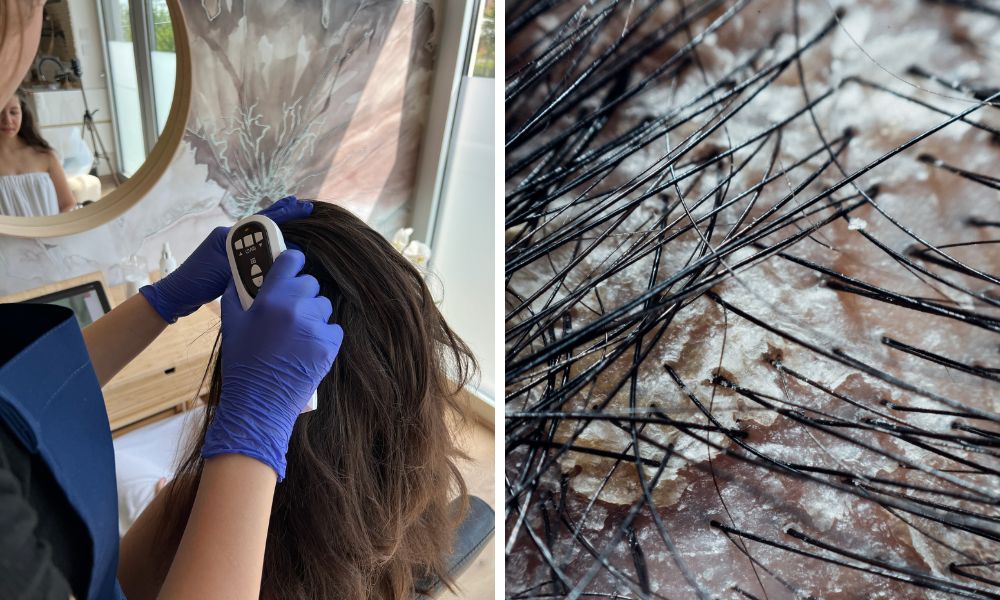
What can help in identifying the causes?
In identifying the causes, carefully observing the symptoms and analyzing the circumstances can be helpful. It’s important to note whether the pain is short-lived or becomes chronic. For example, a burning sensation after dyeing your hair is likely to be temporary, while ongoing pain could indicate deeper issues, such as inflammation or infection.
Identifying the triggering factors also plays a key role. It’s worth noting when the pain started, which hair care products you used beforehand, or whether you’re going through a stressful period. This information can not only help understand the causes but can also be valuable for the specialist in making an accurate diagnosis. Accurate observation and uncovering the causes provide an opportunity to target the treatment of scalp pain and prevent further issues from arising.
Scalp pain treatment options
There are several treatment options available to alleviate scalp pain, many of which can be easily applied at home. Additionally, lifestyle changes and the use of appropriate products can play a key role in resolving the issues. Below, we present the most effective methods.
Hair Care Routine
One of the most important steps in treating scalp pain is selecting the right hair care products. Using gentle, pH-neutral shampoos and products based on natural ingredients helps soothe the irritated scalp and restore its balance.
Oxygeni Hair products, made from natural ingredients, are particularly recommended for those with sensitive skin as they do not contain irritating substances and support the regeneration of the scalp.
Scalp massage is also an effective solution as it improves blood circulation, thereby stimulating oxygen supply to the scalp and aiding cell regeneration. The Head Spa is specifically developed for scalp issues. This professional treatment not only relaxes the scalp but also helps remove impurities and irritants with its deep-cleansing properties.
At-home treatments also include the use of cooling gels or aloe vera, which soothe inflamed or irritated skin. Aloe vera has natural anti-inflammatory properties and can provide immediate relief for sensitive scalps.
lifestyle CHANGE
Lifestyle factors play a crucial role in the treatment and prevention of scalp pain. Stress management is particularly important, as chronic stress can cause muscle tension on the scalp, which can further worsen the pain. Meditation, yoga, and other relaxation techniques help relax the muscles and contribute to scalp health.
A healthy diet and proper hydration are also essential for improving the condition of the skin and scalp. Scalp health is closely linked to the body’s nutrient supply, so it’s beneficial to consume foods rich in vitamins and minerals.
A combination of at-home treatments and lifestyle changes can effectively help relieve scalp pain and provide a long-term solution to the problem.
SCALP PAIN prevention
To prevent scalp pain, it is important to pay special attention to healthy hair care habits, a proper lifestyle, and stress management. Prevention plays a key role not only in alleviating pain but also in maintaining the long-term health of the scalp.
Hair care habits
One of the most important steps is to establish a hair care routine. Gentle washing and combing are essential, especially when the scalp is already sensitive. Use mild, natural shampoos that do not irritate the scalp. Excessive force when combing can easily cause damage, so always be careful to work with gentle movements. Changing hair styling habits can also contribute to preventing scalp pain. Avoid tight ponytails, buns, or braids that constantly pull on the hair and scalp. When styling your hair, opt for looser solutions that do not put stress on the hair follicles.
Healthy lifestyle
Maintaining scalp health is closely linked to nutrition and hydration. It’s important to consume foods rich in iron, zinc, and other essential minerals. These nutrients support the regeneration of hair follicles and the scalp, contributing to healthy hair growth. Regular hydration, both internally (by drinking enough water) and externally (through the use of proper hair care products), is also crucial.
Stress-reducing activities
Reducing stress is crucial since chronic tension negatively impacts the scalp’s blood circulation and muscles. A weekly scalp massage, which stimulates blood flow and relaxes the muscles, can be an effective solution. For example, the Head Spa treatment not only alleviates pain but also helps prevent scalp issues in the long term. This treatment is not only relaxing but also has deep cleansing and regenerating effects, making it an ideal choice for those who want to prevent scalp pain.
Additionally, it’s worth incorporating relaxation activities into your daily routine, such as yoga, meditation, or a pleasant walk. These methods not only reduce stress but also improve overall well-being.
Preventing scalp pain requires awareness and attention. Proper hair care habits, a healthy lifestyle, and stress management work together to maintain scalp health and help avoid unpleasant symptoms. In the next section, we will summarize the key takeaways and provide additional tips for preserving scalp health.
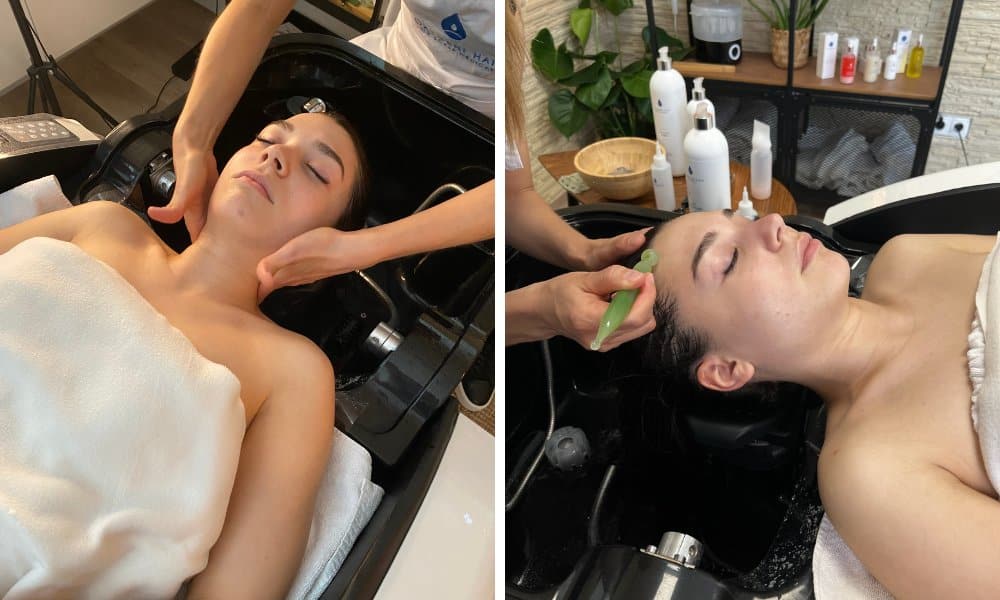
Why is it important to treat scalp pain?
Scalp pain is not just a temporary discomfort; it is often a sign of underlying issues that require deeper attention. While many people tend to downplay this symptom, timely intervention not only helps alleviate pain but can also prevent further health problems from developing. Whether the pain is caused by tight hairstyles, irritating hair care products, or stress, understanding and treating scalp pain is key to maintaining long-term health.
The causes behind scalp pain are varied. Ranging from the mechanical pulling caused by tight ponytails to inflammatory skin conditions and circulation issues, many factors can contribute to the development of symptoms. A burning, itching, or pressure-sensitive scalp not only causes discomfort but often also affects the health of hair follicles. Therefore, it is especially important to pay attention at the first signs of discomfort and start addressing the underlying causes of the problem.
One of the fundamental steps in alleviating pain is establishing proper hair care habits. Gentle hair care, using natural products, and avoiding overly tight hairstyles can all contribute to maintaining the health of the scalp. Professional treatments, such as Head Spa, with their regenerative effects, not only relieve pain but also support long-term scalp health.
Moreover, lifestyle factors like stress management and a nourishing diet also play a crucial role in preventing scalp pain. Stress often directly impacts the blood circulation and muscles of the scalp, leading to pain and tension. Regular relaxation activities such as yoga or meditation can effectively reduce stress levels while improving the overall condition of the scalp. Additionally, proper nutrition and hydration are essential for hair and scalp regeneration. Timely recognition and treatment of scalp pain not only help relieve current symptoms but also preserve scalp health in the long run. If the pain persists or returns regularly, it is advisable to consult a professional for an accurate diagnosis and appropriate treatment.
Overall, treating and preventing scalp pain requires a complex and holistic approach. The combination of proper hair care habits, stress management techniques, and a nourishing lifestyle can contribute to the long-term health of the scalp. Timely attention and intervention not only can help eliminate pain but also ensure that our scalp remains healthy, balanced, and pain-free.
Writer: Mónika Habuczki
OXYGEN THERAPY AND OXYGENI HAIR PRODUCT REVIEWS



